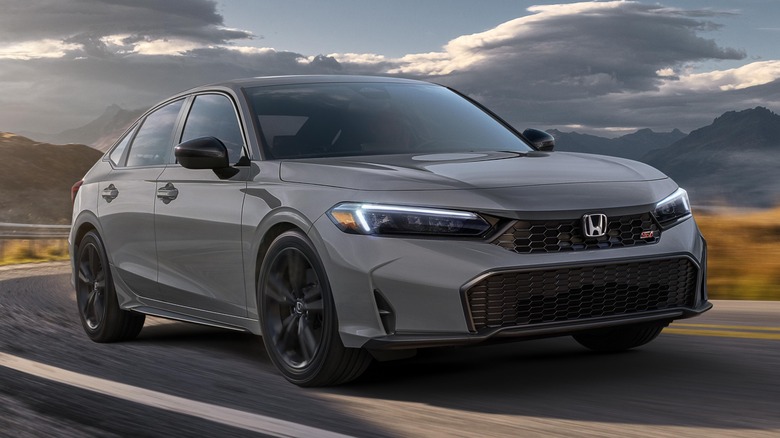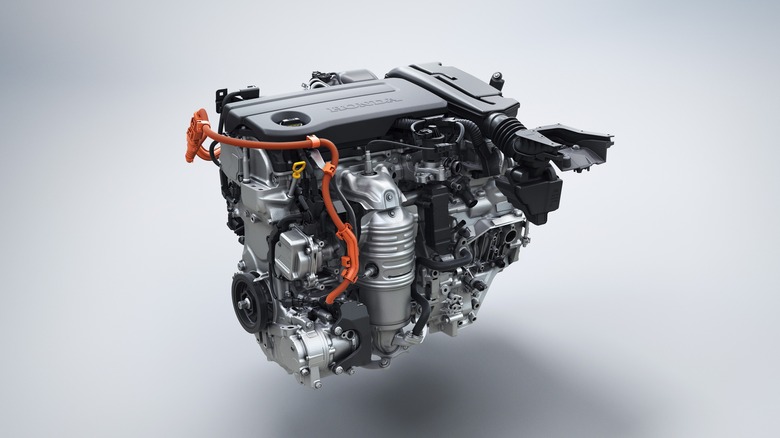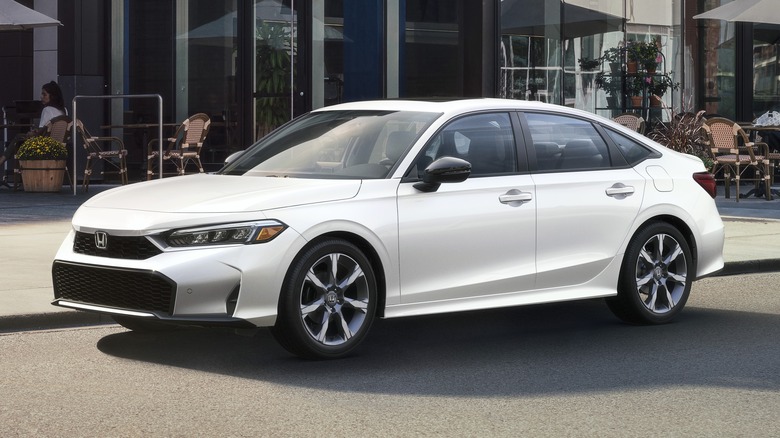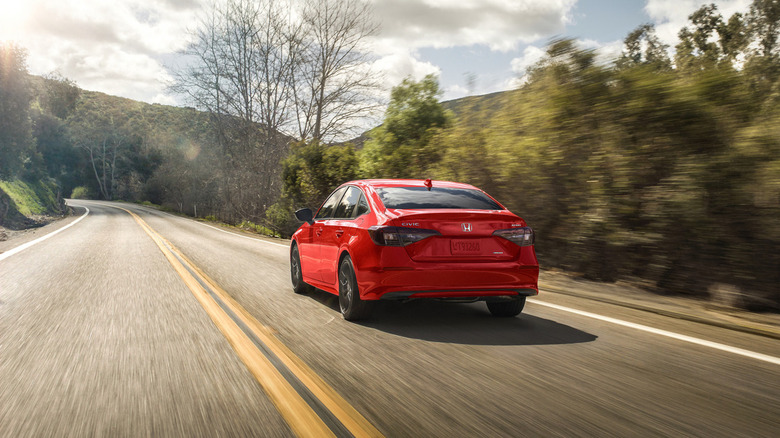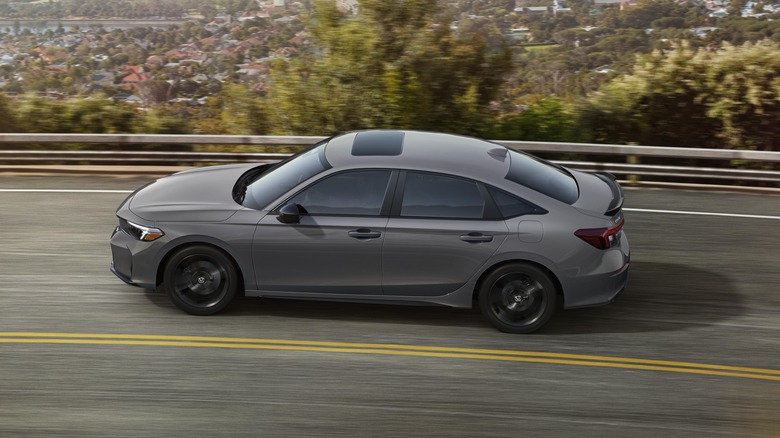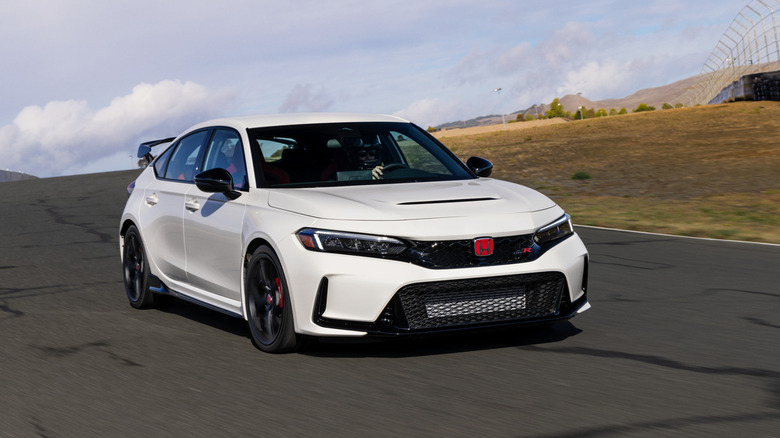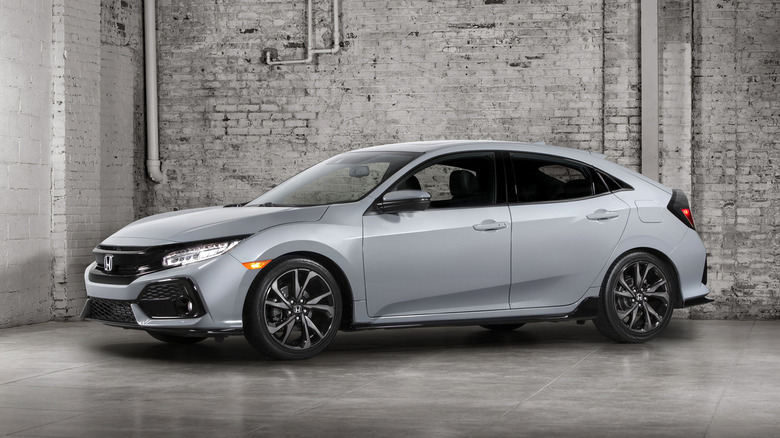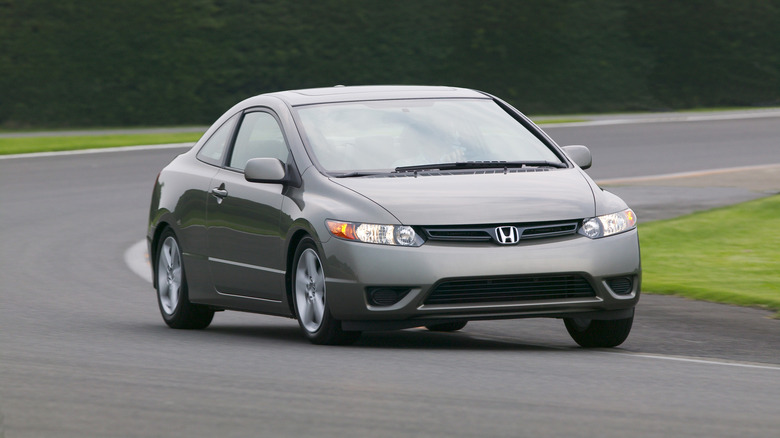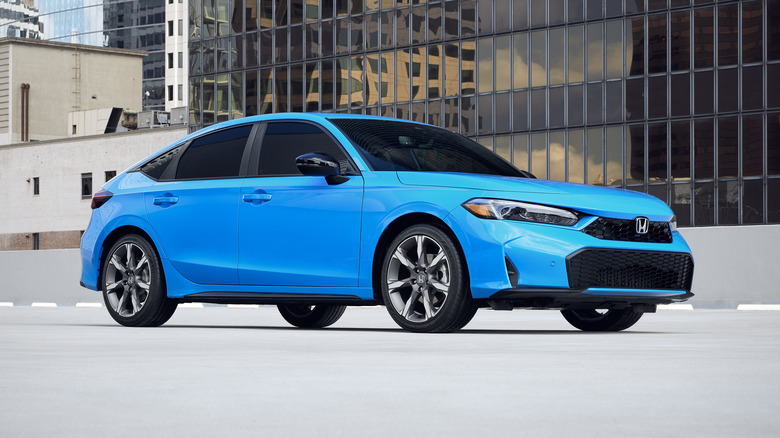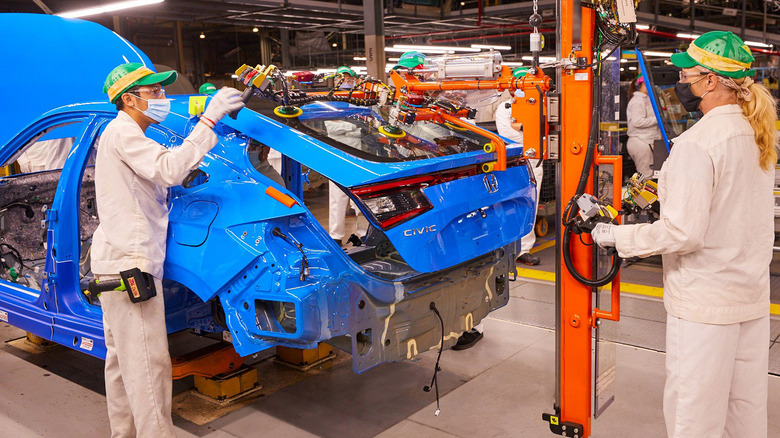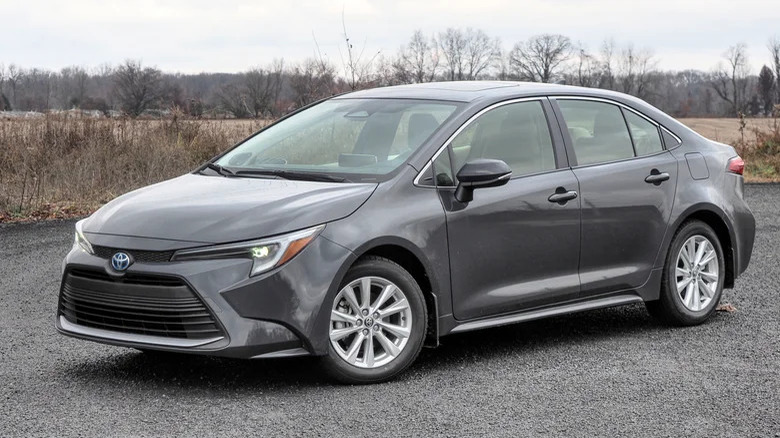10 Things You Should Know Before Buying A Honda Civic (New Or Used)
After more than five decades of continuous production, the Honda Civic remains one of the most popular small cars on the market. It has adapted to decades of changing market tastes, winning over owners thanks to its practical nature, fuel-sipping powertrains, and affordable asking price. Honda has done an excellent job of keeping those key attributes unchanged throughout its production lifespan, despite the fact that the car itself has gone through a series of major changes that make the Civic of today a vastly different car to the original.
Buying a new Civic is still a safe bet — the car's wide range of trims and body styles ensures that there's something for everyone, and each is competitively priced against what else is on offer in its segment. Used Civics also remain highly popular for good reason, whether they're one year or 20 years old.
Before you head out to buy one, there are a few things worth knowing about the car that should help you make a more informed choice about exactly which trim or model year to pick. Combining the expertise of SlashGear's hands-on review team with data from industry leading sources, we've put together a roundup of things you need to know before heading to a dealership.
The Civic is available with or without a hybrid powertrain
Honda might not have adopted as bold an electrification strategy as other manufacturers, but many of its bestselling cars are now available with hybrid powertrains, including the Civic. The current generation sees the Civic split into two body styles, the Civic Sedan and Civic Hatchback, and both offer electrified powertrains.
Non-hybrid Civics come equipped with a 2.0L four-cylinder engine making 150 horsepower. A continuously variable transmission (CVT) is the only transmission option, with higher trims gaining paddle shifters. The Civic's hybrid powertrain combines the 2.0L four-cylinder engine with electric motors to generate a combined 200 horsepower.
While other popular Honda models such as the CR-V offer the option of all-wheel-drive, the Civic remains available in front-wheel-drive only across all trims. Honda's suite of safety tech, called Honda Sensing, also remains unchanged across trims, with systems like lane departure warning, adaptive cruise control, and forward collision warning available even on base-spec models.
For 2025, the Civic starts around $25,000
A key part of the Civic's popularity among buyers has always been its affordability, and the 2025 Civic does nothing to change that. The cheapest variant available is the Civic LX Sedan, which starts at $25,345 including Honda's compulsory shipping and handling fees. The next step up in the Civic Sedan range is the Sport, which adds extras including 18-inch black alloy wheels and heated side mirrors. It starts at $27,345 including fees. The cheapest hybrid Civic Sedan is the Sport Hybrid, which starts at $29,845, while the $32,845 Sport Touring Hybrid tops out the main Civic Sedan range.
The Civic Hatchback is available in only three trims, with the $28,545 Sport trim being the cheapest — and only non-hybrid — option. The $31,045 Sport Hybrid and $34,045 Sport Touring Hybrid round out the lineup. In addition to the main Civic range, Honda also offers two hotter Civic models, the Civic Si and Civic Type-R, with the former only available as a sedan and the latter only as a hatchback. The Civic Si starts from $31,045 while the Civic Type-R is by far the priciest variant at $45,890.
Efficiency figures vary significantly between trims
Another key reason for the Civic's long-standing popularity with buyers is its efficiency, although some variants of the current-generation car are considerably more efficient than others. The Civic's hybrid powertrain is by far the best performer, achieving impressive EPA ratings of 50 mpg city, 47 mpg highway, and 49 mpg combined. Only the Hyundai Elantra Hybrid offers better fuel efficiency in the segment, with most of the Civic's rivals being considerably less frugal.
The non-hybrid Civic is still a strong performer, but it can't match the fuel sipping credentials of the hybrid. Efficiency varies slightly between trims, with the non-hybrid achieving between 44 mpg and 46 mpg combined. Unsurprisingly, both performance-oriented variants of the Civic fare worst for fuel efficiency, with the added power offered in the Civic Type-R translating to EPA ratings of 22 mpg city, 28 mpg highway, and 24 mpg combined. Those figures will drop even further for drivers intent on making full use of their car's improved performance.
The Civic Si is an affordable enthusiast daily driver
For buyers keen to prioritize driving fun over maximum efficiency, the Civic Si offers an affordable entry point into Honda's performance vehicle lineup. SlashGear tested the car at the launch of the current generation in 2022, and found it to be a thoroughly enjoyable successor that more than matched up previous Si generations.
It sports a different engine to other non-hybrid Civics, packing a turbocharged 1.5L four-cylinder that's good for 200 horsepower. That might be a relatively modest figure by modern standards, but it's enough to inject some excitement into the driving experience, both when pushing the car and when driving at more everyday speeds.
Our reviewer found it to be just as comfortable carving through winding California mountain roads as it was on the state's busy highways, making it highly appealing as a daily driver. Sure, it doesn't quite boast the performance chops of the Civic Type-R, but then, it doesn't cost anywhere near as much, either.
The Civic Type-R is hot hatch excellence
The Civic Type-R might cost significantly more than any other Civic, but for those who can justify the outlay, few hot hatches are better. The current generation Type-R debuted for the 2023 model year and brought with it new looks, improved handling, and a revised turbocharged four-cylinder engine making 315 horsepower. The appeal of the car is much the same as before — it combines the Civic's everyday practicality and reliability with the performance that's usually reserved for weekend toys.
The latest Type-R arguably nails the formula better than ever, with its slightly less over-the-top looks compared to its predecessor being preferable for drivers who want maximum enjoyment without drawing as much attention. The car still looks visibly different from the standard Civic, though, with unique wheels, a body kit, and a rear wing to differentiate it from the crowd.
Much like the Civic Si, the Type-R is only available with a manual transmission, which further reinforces its enthusiast credentials. SlashGear found the six-speed 'box to be exceptionally good, while the car's 2.0L engine provided plenty of grunt to match the car's sporty looks.
Older Civic generations are readily available on the used market
The Civic has been through 11 different generations since it first launched in 1972, with the current generation being launched for the 2022 model year. Buyers looking for a used Civic could consider a 2022, 2023, or 2024 model, but older generations of the car are also worth considering.
The 10th generation of the car debuted for 2016 and offered a turbocharged engine, a hatchback bodystyle, and updated safety and convenience technology over its predecessor. It was also the first generation where the enthusiast favorite Type-R variant was officially offered in America. Before that, the ninth generation Civic was produced from 2012 to 2015 with more conservative styling and a range of frugal engines.
When buying any older car, it's always worth asking plenty of questions to ensure you're buying an example that's been well looked after. The Civic has a reputation for being reliable even after many years of service, but that reputation won't count for much if a previous owner has neglected the car. Be sure to inspect both the interior and exterior of the car before purchasing, and ask for evidence of service records to prove the car's maintenance schedule has been followed.
Some older model years are worth avoiding
The Civic is largely a safe bet when it comes to build quality, but it's not got a perfect record. Some model years have drawn significantly more complaints from owners than others, and so they're worth avoiding, especially since there are only a handful that stick out from the rest. The worst offender for owner complaints according to data from the NHTSA is the 2006 Civic and Civic Hybrid, both of which have around 1,400 complaints as of this writing.
The 2007 model years of both Civic variants doesn't fare well either, with both racking up over 1,200 complaints. The suspension is a common complaint among owners of each model year, with hundreds of reports stating that the rear tires were wearing prematurely thanks to defective rear suspension. Coolant leaks are also commonly reported, frequently causing partial or total engine failure.
The 2001 Civic is also among the most frequently complained about, with hundreds of owners reporting engine issues and many others claiming the car has issues with airbag deployment despite a recall for its airbags being issued in 2019.
There's no need to worry about excessive depreciation
Virtually all cars are subject to some level of depreciation as they age, but the Civic depreciates less than average. According to KBB, the average new car will drop in value around 60% over its first five years, with depreciation levels slowing considerably as the car gets older. This is great news for used buyers, who are able to pick up used cars that are just a few years old for a significant discount off their original retail price.
Buyers looking for a new Civic won't have to worry too much about excessive depreciation either, as KBB estimates that a 2024 Civic will depreciate 44.6% over five years, making it significantly better at retaining market value than average. On the flip side, that means that buyers on tighter, fixed budgets might have to look for a used Civic that's a few years older than similar cars from rival manufacturers.
Most American market Civics are made in North America
The launch of the latest Civic generation for the 2022 model year saw the hatchback variant of the car manufactured in the U.S. for the first time. The hatchback is produced in Honda's facility in Greensburg, Indiana, while sedan variants are built at a facility north of the border in Ontario, Canada. Many older Civic models are also American made, with Honda's North American manufacturing operations stretching back 35 years and churning out more than 10 million Civics by the time the 11th generation was launched.
The Civic Type-R remains an import model, although it also saw major changes with the launch of the latest generation. Previous generations of the hot hatch were built in Honda's plant in Swindon in the U.K., alongside American market Civic hatchbacks. When production of the 10th generation Civic ended in 2021, the British plant was closed, with hatchback production moving to North America and Type-R production moving to Japan.
The Civic has plenty of competition
The Civic's mix of practicality and liveability has turned many buyers into loyal Honda fans over its decades on sale, but for those happy to look outside the Japanese automaker's lineup, there are plenty of Civic rivals to consider. Buyers looking for an alternative to the Civic Hatchback might want to look at the sportier Mazda3, which offers optional all-wheel-drive and a cabin that, in top trims, is far more upscale than the car's affordable MSRP might suggest.
Much like the Civic, the Toyota Corolla is another bestseller in the segment, and for good reason. It's affordable, practical, and decently efficient in hybrid form, even if it's not the most exciting car in its class. South Korean automakers shouldn't be discounted either, with sedans like the Hyundai Elantra offering sharp looks and generous equipment levels at a temptingly affordable price. That said, the Civic remains a safe and appealing choice across virtually all trims, from the base-spec Civic LX Sedan to the range-topping Civic Type-R. It's not difficult to see why Honda sold over 27 million Civics in its first 50 years of production, and the 2025 model remains just as appealing as ever.
